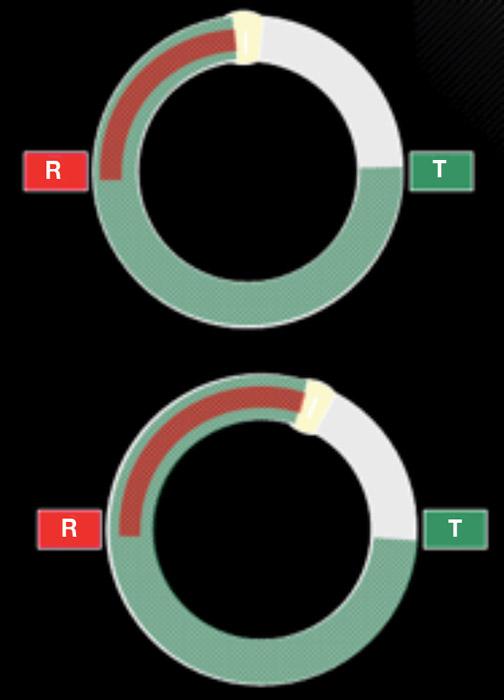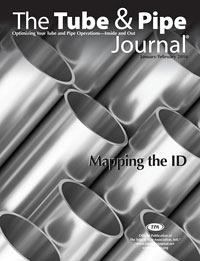Marketing Manager
- FMA
- The Fabricator
- FABTECH
- Canadian Metalworking
Categories
- Additive Manufacturing
- Aluminum Welding
- Arc Welding
- Assembly and Joining
- Automation and Robotics
- Bending and Forming
- Consumables
- Cutting and Weld Prep
- Electric Vehicles
- En Español
- Finishing
- Hydroforming
- Laser Cutting
- Laser Welding
- Machining
- Manufacturing Software
- Materials Handling
- Metals/Materials
- Oxyfuel Cutting
- Plasma Cutting
- Power Tools
- Punching and Other Holemaking
- Roll Forming
- Safety
- Sawing
- Shearing
- Shop Management
- Testing and Measuring
- Tube and Pipe Fabrication
- Tube and Pipe Production
- Waterjet Cutting
Industry Directory
Webcasts
Podcasts
FAB 40
Advertise
Subscribe
Account Login
Search
Sound waves determine weld soundness
EMAT technique provides alternative NDT process for tube, pipe producers
- By Seth McGuire
- January 19, 2016
- Article
- Tube and Pipe Production

Figure 1
Although piezoelectric transducers and electromagnetic acoustic transducers do the
same thing, propagate an ultrasonic wound wave through the material under test,
they do it in different ways.
Nondestructive testing (NDT) plays two critical roles in welded tube and pipe production. First, tests conducted early in the production process can save the company time and money by detecting problems that may lead to poor weld quality. Second, when problems occur, immediate detection can prevent creating large amounts of scrap or substandard product.
The electric resistance welding (ERW) process isn’t perfect. Typical defects include entrapments (black penetrators), prearcs (white penetrators), lack of fusion (LOF), LOF at edges (puckers) or midwall, cast weld, porosity, stitching, hook cracks, and paste welds (cold welds). After welding, ID and OD trim (under- or overcut) can result in downgraded or scrapped product. Before welding, skelp entering the line can contain surface or internal defects, or can be out of specification for thickness.
Traditional techniques for ERW inspection use piezoelectric transducers. While highly efficient and versatile, piezoelectric transducers need to be coupled to the part under inspection with high pressure or a liquid medium. These can limit the scanning ability or produce interferences, respectively.
An alternative process, electromagnetic acoustic transducer (EMAT), is a more recent development that uses two interacting magnetic fields to generate ultrasonic sound waves in the part. A relatively high frequency (RF) field generated by electrical coils interacts with a low frequency or static field generated by magnets to generate a Lorentz force in a manner similar to that of an electric motor. This disturbance is transferred to the lattice of the material, producing an elastic wave. In a reciprocal process, the interaction of elastic waves in the presence of a magnetic field induces currents in the receiving EMAT coil circuit. For ferromagnetic conductors, magnetostriction produces additional stresses that enhance the signals to much higher levels than could be obtained by the Lorentz force alone. Various types of waves can be generated using various combinations of RF coils and magnets. See Figure 1.
Because the sound is generated in the part inspected instead of the transducer, EMAT has several characteristics that appeal to tube and pipe producers:
- Dry inspection. Because EMAT doesn’t use a couplant, it’s well-suited for inspecting very hot and very cold parts. This property also facilitates EMAT’s integration into automated inspection systems.
- Surface conditions. EMAT is impervious to common skelp surface conditions, such as contaminants, mill scale, and surface roughness.
- Sensor deployment. Because EMAT generates sound waves in the material under test, Snell’s law of refraction does not apply, and the sensor angle doesn’t affect the direction of propagation. A single EMAT sensor can be applied to several tube diameters without having to change wedges. Also, small variations in the sensor angle do not change the direction of sound and the quality of the inspection.
- Guided waves. EMAT is efficient for generating guided waves that can be used to inspect small-diameter tubes without modifying the location of the sensors on the part.
- Wide vertical beam. EMAT coils generate a wide vertical beam that fills up the volume of the material. Whereas some NDT processes need several sensors or a phased array, a single EMAT sensor allows detection of ID, OD, and midwall defects.
Weld Inspection
On small pipes, guided waves are ideal for ERW inspection. An EMAT transmitter can be located at 90 degrees, sending sound waves clockwise, with a receiver at 270 degrees to detect reflections from the weld. A second set of sensors with the transmitter at 270 degrees and receiver at 90 degrees sends sound counterclockwise to complement the first set. Guided waves fill the volume of the material, thereby enabling inspection of the entire weld in one shot for detection of hook cracks, zipper welds, lack of fusion, and mismatch with greater reliability than angled beams on small tubes. EMAT also can be complemented with eddy current technology for detection of point-type defects, and it permits up to 55 degrees of weld drift during inspection (see Figure 2).
On large-diameter pipes, welds can be inspected with EMAT immediately after the welding process, which minimizes waste. Inspection without couplant permits installation immediately after the welding head to detect all weld discontinuities, API standard defects (penetrators, LOF, cast weld, porosity, hook cracks, and stitching), and trimming defects (ID and OD). Trimming problems alone can account for much of the scrapped pipe because they are detected long after the problem begins.
Skelp Inspection and Thickness Measurement
Skelp inspection for planar defects is performed using arrays of sensors that generate normal beam 0-degree waves. The sensors can be placed across the entire width of the skelp or concentrated in the weld zones only. EMAT is much less sensitive to vibrations or sensor movement and can be used at very high speeds for screening of skelp. The same normal beam technique can be used for thickness measurement of the skelp with resolution of ± 0.0001 in. (2.5 µm).
About the Author
Seth McGuire
2940 Perrowville Road
Forest, VA 24551
434-948-1301
About the Publication
Related Companies
subscribe now

The Tube and Pipe Journal became the first magazine dedicated to serving the metal tube and pipe industry in 1990. Today, it remains the only North American publication devoted to this industry, and it has become the most trusted source of information for tube and pipe professionals.
start your free subscription- Stay connected from anywhere

Easily access valuable industry resources now with full access to the digital edition of The Fabricator.

Easily access valuable industry resources now with full access to the digital edition of The Welder.

Easily access valuable industry resources now with full access to the digital edition of The Tube and Pipe Journal.
- Podcasting
- Podcast:
- The Fabricator Podcast
- Published:
- 04/16/2024
- Running Time:
- 63:29
In this episode of The Fabricator Podcast, Caleb Chamberlain, co-founder and CEO of OSH Cut, discusses his company’s...
- Trending Articles
Zekelman Industries to invest $120 million in Arkansas expansion

3D laser tube cutting system available in 3, 4, or 5 kW

Corrosion-inhibiting coating can be peeled off after use

Brushless copper tubing cutter adjusts to ODs up to 2-1/8 in.

HGG Profiling Equipment names area sales manager

- Industry Events
16th Annual Safety Conference
- April 30 - May 1, 2024
- Elgin,
Pipe and Tube Conference
- May 21 - 22, 2024
- Omaha, NE
World-Class Roll Forming Workshop
- June 5 - 6, 2024
- Louisville, KY
Advanced Laser Application Workshop
- June 25 - 27, 2024
- Novi, MI



























